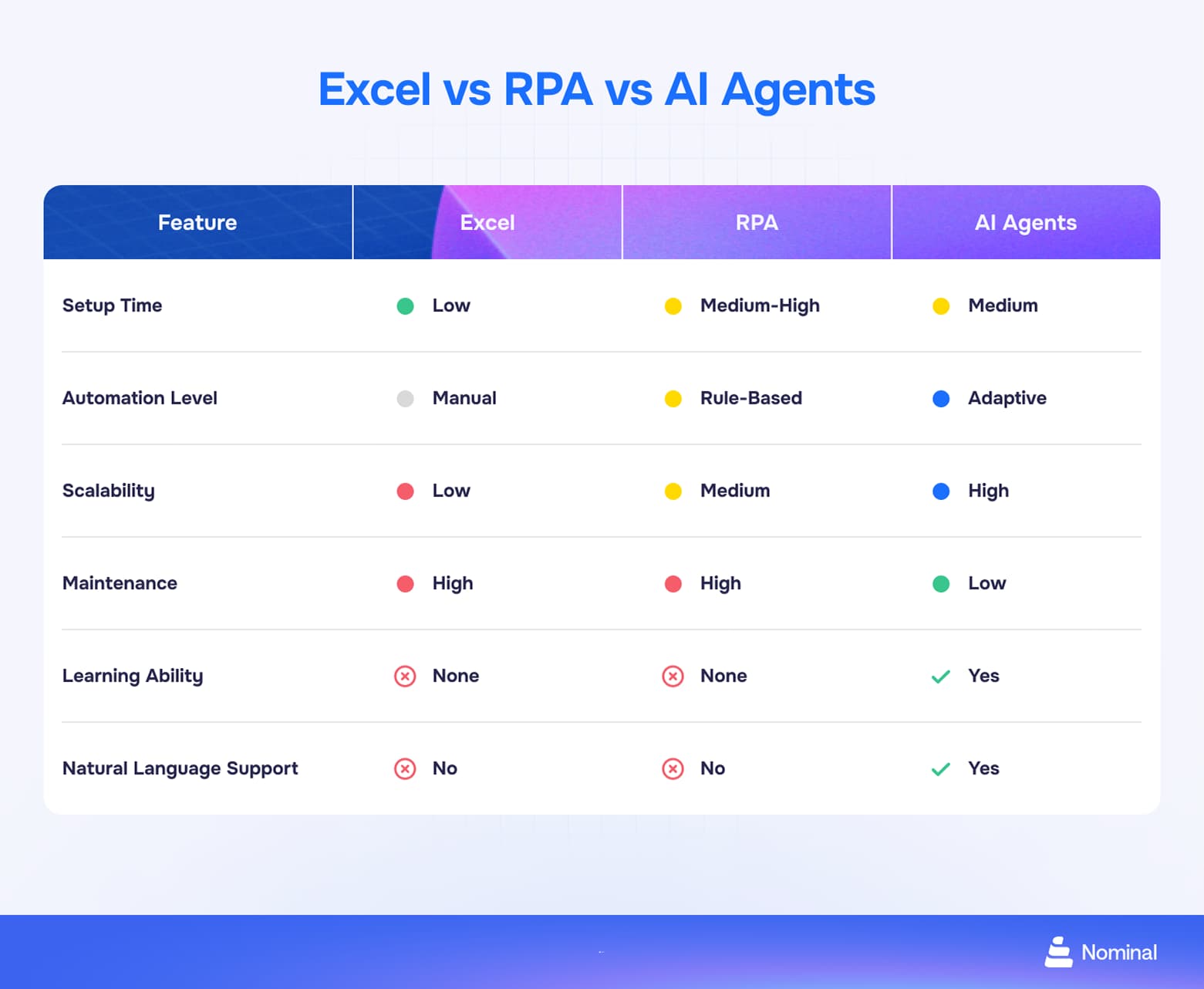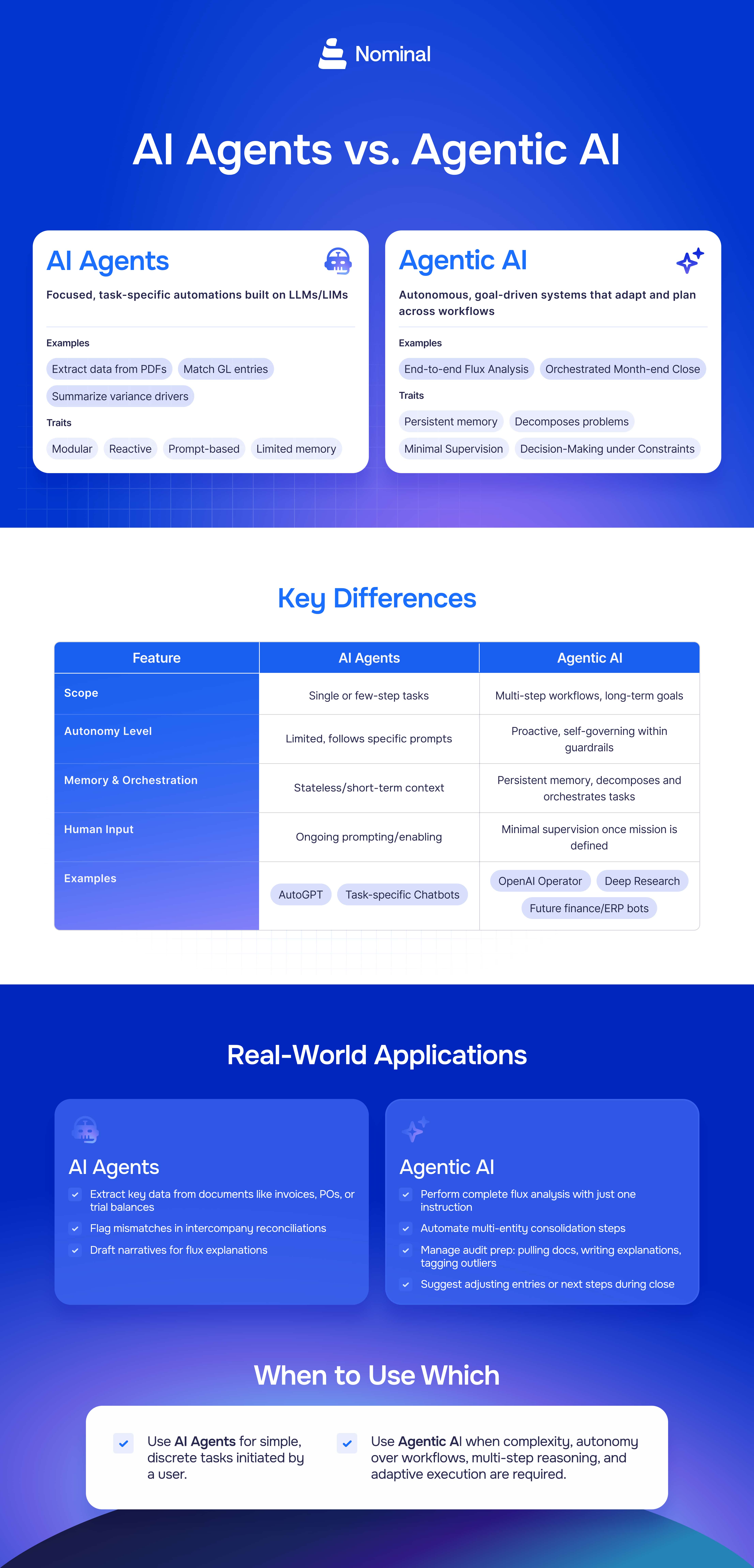Explore how artificial intelligence is redefining financial strategy, forecasting, and decision-making.
What You’ll Learn:
- Identify the hidden inefficiencies in manual finance workflows
- Explain how automation is evolving into intelligent finance
- Understand the difference between AI agents and agentic AI
- Recognize where your team may be over-relying on spreadsheets
- Start mapping how AI fits into your close and consolidation process
💡 Quick Tip
Manual work isn’t just slow. It’s risky. Every hour spent reconciling is an hour not spent analyzing.
{{line-divider}}
1. The AI Imperative in Finance
Over the past decade, finance teams have invested heavily in process optimization. Yet most still operate in a reactive, spreadsheet-driven environment.
According to Gartner, one in three accountants regularly makes multiple errors per week due to capacity constraints. And while nearly all companies are investing in AI, McKinsey reports that just 1 percent consider themselves fully mature in its deployment.

The urgency is real. Manual tasks like reconciliations, consolidations, and close processes consume up to 60 percent of finance teams’ time. That leaves little room for strategic thinking or proactive analysis. Meanwhile, organizations that have adopted intelligent automation are already seeing improvements in forecasting accuracy, reporting speed, and audit readiness.
This lesson explores why AI is no longer a future concept but a present-day necessity. You’ll learn how forward-looking finance teams are using it to eliminate repetitive work, uncover real-time insights, and shift their focus from data wrangling to strategic decision-making.
Want to dive deeper? Explore the blog posts:
{{line-divider}}
2. The Hidden Cost of Manual Work
Despite years of system upgrades, manual work still dominates core finance tasks. Month-end close, intercompany eliminations, and reconciliations often happen outside the ERP, buried in spreadsheets and shared drives.
According to PwC, finance teams spend up to 60 percent of their time collecting and validating data. This isn’t just inefficient. It introduces risk, slows decision-making, and limits your team’s ability to focus on forward-looking analysis.
Take this quick quiz to find out where your finance operations stand, and what could be holding you back:
Manual effort isn't just a workload issue. It's a visibility issue. Without system integration and intelligent automation, teams are forced to rely on workarounds that fragment data and delay insights. This lesson walks through the hidden impacts and sets the stage for smarter, more connected workflows.
Explore further:
{{line-divider}}
3. From Manual to Intelligent Finance
Automation in finance isn’t new. But most teams are still operating in phase one with basic scripts, batch uploads, and Excel-based workarounds. These tools help, but they’re rigid, hard to scale, and require constant oversight.
Now, finance leaders are moving toward intelligent automation. These systems learn, adapt, and surface insights without needing to be told exactly what to do. AI-powered workflows are transforming how teams approach financial close, anomaly detection, and operational reporting.
To see the difference in action, watch a side-by-side case example of a finance process run with and without AI. This quick comparison highlights the real impact of shifting from manual workflows to intelligent agents.
Watch the Case Example Finance with vs. without AI:
The difference in capabilities is more than technical. It’s strategic. Here’s how Excel, RPA, and AI agents compare when it comes to scale, speed, and intelligence:

This lesson helps you understand where your team stands today and what’s possible as you move beyond templates and scripts to systems that truly assist your work.
Dig deeper:
{{line-divider}}
4. AI Agents and the Next Step in Automation
AI agents represent the next evolution in finance technology. Unlike rule-based bots or macros, these tools can interpret context, perform multi-step tasks, and interact with your systems in real time.
Think of an AI agent as an autonomous teammate. It can reconcile accounts, monitor anomalies, and even explain outliers. Most importantly, it improves with every task it performs.
In this lesson, you’ll explore what sets AI agents apart and how they’re already transforming workflows across close, consolidation, and financial controls.
Watch the Webinar “AI Agents in Finance & Accounting: Beyond the Hype”
Want to learn more?
{{line-divider}}
5. Agentic AI in Practice
Agentic AI takes automation a step further. It does not just assist. It plans, decides, and adapts in real time, coordinating complex finance tasks across systems without needing detailed instructions.
In finance, this unlocks a new operating model. Teams can move from batch processing and manual checks to continuous consolidation, proactive alerts, and real-time reporting. Instead of reacting to data, they can focus on guiding the business with confidence.
In this lesson, you’ll explore how agentic AI works, how it differs from traditional AI agents, and what it enables in day-to-day finance operations.
To help clarify the shift, we created a side-by-side infographic showing how AI agents compare to agentic AI in terms of autonomy, use cases, and outcomes.

Watch the Webinar Understanding Agentic AI in Accounting:
{{line-divider}}
You’ve seen how AI is reshaping the finance function. From reducing manual work to enabling intelligent workflows that scale with your business. Whether you’re leading strategy, managing close and consolidation, or handling day-to-day reconciliations, the opportunity is clear. AI isn’t replacing finance. It’s elevating it.
The next modules will take this foundation further with hands-on tactics, prompting frameworks, and real use cases from finance teams already seeing results.
{{demo-cta}}





